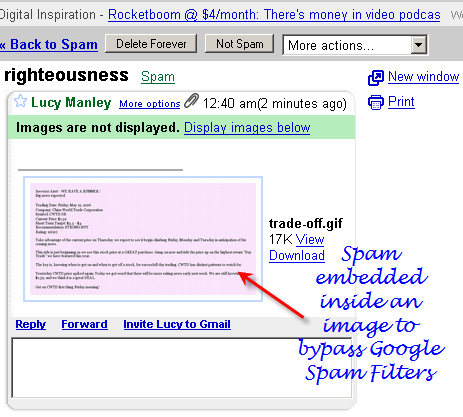Gmail spam filters are definitely better that Hotmail or Yahoo Mail spam guard but spammers and junk email senders have discovered a new workaround to trick the GMail spam filters and enter the recipient's GMail inbox.

The email spammer's latest trick is to embed the text in an image with a plain background and send the picture as an attachment. GMail will automatically render the image when you open the email message since the image is an attachment and not linked to an external website.
Most of this spam has a .ru domain in the sender's address and try to sell Valium, fake Rolex watches or Stock scams.
You cannot create GMail filters as there isn't any text inside the email message for the email filter to work. The only option for GMail users is that they click the Report Spam button that removes the spam message from the inbox view and sends alerts the GMail team about the message.
The spam contains images spouting everything from stock scams to Viagra, and its volume has more than doubled since April, according to analysis by anti-spam vendor IronPort Systems.
Image spam is not rare anymore and accounts for 21% of all spam, compared with just 1% in late 2005. Most image-based spam comes in the form of stock scams, which contain the same basic language within a shaded box.

The email spammer's latest trick is to embed the text in an image with a plain background and send the picture as an attachment. GMail will automatically render the image when you open the email message since the image is an attachment and not linked to an external website.
Most of this spam has a .ru domain in the sender's address and try to sell Valium, fake Rolex watches or Stock scams.
You cannot create GMail filters as there isn't any text inside the email message for the email filter to work. The only option for GMail users is that they click the Report Spam button that removes the spam message from the inbox view and sends alerts the GMail team about the message.
The spam contains images spouting everything from stock scams to Viagra, and its volume has more than doubled since April, according to analysis by anti-spam vendor IronPort Systems.
Image spam is not rare anymore and accounts for 21% of all spam, compared with just 1% in late 2005. Most image-based spam comes in the form of stock scams, which contain the same basic language within a shaded box.